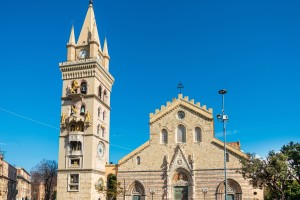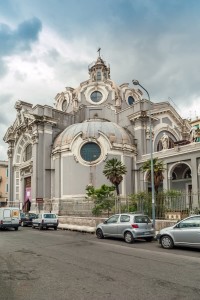
©Bigstock.com/ilolab
The Strait of Messina is also known as the gateway to Sicily. It doesn’t just connect two bodies of water – the Tyrrhenian Sea and Ionian Sea – but, first and foremost, the island with the Italian mainland. The link between Villa San Giovanni in Calabria (a few kilometres north of Reggio Calabria) and Messina is one of the most important junctions in all of Italy. One thing that’s overlooked far too often: Messina is a stunning, fascinating city of arts that managed to retain its magical aura despite numerous devastations and natural disasters. Visiting the city of arts Messina produces many a big surprise and should be part of every Sicilian holiday. Find out what the city has in store for you.
The ups and downs of Messina’s history
Messina’s roots can be traced back to the 8th century BC when Ionian colonists settled on this land and called it Zancle, which comes from the Sicel term for “scythe” and was likely inspired by the scythe-like shape of the land tongue. The name Messene came in the 5th century BC. Carthaginians and Mamertines pillaged and devasted the city, the latter eventually setting the First Punic War in motion. It resulted in Messina becoming a free city allied with Rome, then a part of the Roman province of Sicily as a major maritime base crowned by a tall lighthouse. However, the economic boom period wore off during the 9th century. The city saw many different conquerors, such as the Arabs, the Normans, and even a brief occupation by King Richard I (“The Lionheart”).
This set several highly eventful centuries in motion that saw Messina experience all the highs and lows imaginable. Genoese ships brought the black death to Western Europe via Messina in 1347. Contemporary reports talk about the arrival of “death ships” floating to shore without a single survivor on board. On a slightly different note, Messina’s coinage left its distinct mark on medieval currency until 1678. The city was also the seat of the Consolato del Mare, regulating body of global naval trade, and the Consolato della Seta, the consulate of silk traders. A severe earthquake with subsequent tidal waves destroyed most of the city, such as the cathedral and several palaces, in 1783. The rebuilding efforts put greater emphasis on wider roads and spacious squares. Another earthquake with a tsunami in 1908 levelled 90% of all buildings, over 60,000 people lost their lives. Even the brutal air raids during the Second World War didn’t manage to dishearten the population who rebuilt everything again. That’s why the city of arts Messina is so richly layered today.
Cathedral and cathedral square
As you’ve just read, the Cathedral Santa Maria Assunta was destroyed and rebuilt several times. Hardly anything is left of the original basic fabric of the church consecrated in 1197. A fire in 1254 destroyed the panelled ceiling. The body of the recently deceased and laid out King Conrad IV also fell victim of the flames. Walls collapsing during the two aforementioned earthquakes destroyed the interior, fires causes by war bombs burned pretty much everything inside to the ground. Its current basilica-like look with the layout of a Latin cross has heavy Gothic and Norman influences. The main gate is fully Gothic. The three naves are each separated by two rows of 13 pillars each and Corinthian capitals. The mosaic adornment inside the Chapel of the Sacraments is particularly worth seeing. It dates back to the 14th century and is one of the very few gems that survived the countless catastrophes.
The belltower (48 metres tall, newly constructed in 1933) also belongs to the glorious cathedral ensemble. Its medieval style perfectly fits the basilica. The side facing the cathedral square is adorned by scenes depicting religious and historic events with a connection to Messina. It starts moving at noon every day. Find the cathedral treasury at the church’s southside. One thing you must see is the Manta d’oro from 1668. The rather glorious Fountain of Orion with its scenic Renaissance flair neatly caps off this awe-inspiring ensemble.

©Bigstock.com/milosk50
Other sights in Messina
The cathedral square is far from the only highlight in the city of arts Messina. You absolutely should check out the following gems:
- Palazzo Monte di Pietà: There are (and were) plenty of palaces in Messina. This 17th century nobility palace, built on the former site of a small church, certainly is among the most beautiful of its kind. It stands tall with its impressive façade and loggia. You can also marvel at the remains of another church.
- Chiesa del Carmine: The Carmelites had their first church on this site built as early as the mid-13th Today’s structure dates back to 1930, erected after the latest devastating earthquake. The smooth transition between baroque and rococo stylings makes the ostentatious, richly adorned church a sight to behold. It houses several equally spectacular chapels.
- Chiesa della Santissima Annunziata dei Catalani: This 12th century Norman church is one of the few buildings that survived all natural disasters and is now three metres below the rebuilt streets. Here you get to experience fascinating Arab, Byzantine and even Roman influences. The apse is particularly grand.
- Forte del Santissimo Salvatore: Some walls might have been torn down by the 1908 earthquake, but the stilly military-owned fortress mostly managed to maintain its original 16th century shine. You might spy bits and pieces of earlier medieval structures throughout the facility.
- Forte Gonzaga: This fortress was built during the 1540s as a means of protection against the rapidly expanding Ottoman Empire. It rises high above the city overlooking the Strait of Messina. Forte Gonzaga became a city property in 1973. There are plans to turn it into a museum and conference centre.
- Palacultura Antonello da Messina: The Palace of Culture is one of the city’s most modern buildings, at least from the outside. And this very look has been causing a lot of discussions for years due to its strong resemblance to Boston City Hall, which in turn has been supposed to be demolished for a long time. In addition, the Palacultura was built on an archaeological excavation site delaying construction by almost 30 years. Still, the multipurpose centre seems to be remarkably unimpressed by all discussions and controversies.
The Strait of Messina
We initially talked a bit about the strait between Sicily and Calabria. It can only be crossed by water although the ferry is equipped to transport the railway carriages of the line running between Palermo and Naples. Construction of a bridge has been in discussions for decades. A 2003 initiative came very close until all hopes were shattered ten years later. Among the high risks of building such a bridge are strong winds and the risk of earthquakes. Still, endeavours for similar projects continue to this very day.
Then again, the Strait of Messina was crossed in the post-war period . . . electrically. Installation of Sicily’s power supply via the Italian mainland began in 1955. Overhead power lines connected the Calabrian substation Scilla with the Sicilian substation Messina-Santo. The 224-m-high power pole still stand even though all power lines were removed in 1994 in favour of an underwater cable. You can scale the old Sicilian pole with its more than 1,250 steps. The view is astonishing as long as have a good head for heights.
As you can see, Messina is a fantastic, diverse city of arts with many a surprise. Merely travelling there from the mainland is awesome, but the city itself has so much to offer as well. The richly layered architecture with an exciting, forced mix of classic charm, modern wit and clever re-interpretations runs across all squares and through all roads. You absolutely shouldn’t miss out on the city of arts Messina – definitely a must-visit when travelling to Sicily and/or Calabria!